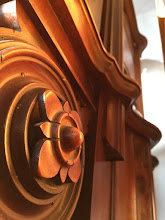 Above: Unknown potato variety and Utrecht Blue Wheat. The wheat heads have begun to form but are green at this stage and not yet "blue".
Above: Unknown potato variety and Utrecht Blue Wheat. The wheat heads have begun to form but are green at this stage and not yet "blue". Delphinium (transplanted from neighbour last year)
Delphinium (transplanted from neighbour last year) Amaranth R158 (Amaranthus cruentus) has decided to grow after all, though still slowly. The R158 variety is described as "developed by Johnny's Selected Seeds and Rodale Research Centre. The leaves and seed heads are mostly red. It is early and heavy yielding." The grains are rich in protein (16 - 18%). Amaranth is believed to be a domesticated form of Pigweed (Amaranthus hybridus). It was historically grown in Central America as long ago as 4000 BC [unreferenced wikipedia info, to be confirmed].
Amaranth R158 (Amaranthus cruentus) has decided to grow after all, though still slowly. The R158 variety is described as "developed by Johnny's Selected Seeds and Rodale Research Centre. The leaves and seed heads are mostly red. It is early and heavy yielding." The grains are rich in protein (16 - 18%). Amaranth is believed to be a domesticated form of Pigweed (Amaranthus hybridus). It was historically grown in Central America as long ago as 4000 BC [unreferenced wikipedia info, to be confirmed]. Carrot going to seed in its second year. The carrot was found in the garden this spring left behind from last year. It was transplanted to an appropriate location so we could collect the seeds.
Carrot going to seed in its second year. The carrot was found in the garden this spring left behind from last year. It was transplanted to an appropriate location so we could collect the seeds. Mystery volunteer plant/weed in compost pile.
Mystery volunteer plant/weed in compost pile. Close-up of the mystery weed flowers.
Close-up of the mystery weed flowers.[UPDATE: Appears likely to be Common Hemp Nettle or Galeopsis tetrahit identified by Dave the Home Bug Gardener, see comments below]
 Possibly some kind of volunteer Wild Mustard (possibly Brassica kaber)? I was debating letting it go to seed and try eating the seeds, but I changed my mind and pulled it. I might try if another one pops up. I think this is the Mystery Weed posted previously.
Possibly some kind of volunteer Wild Mustard (possibly Brassica kaber)? I was debating letting it go to seed and try eating the seeds, but I changed my mind and pulled it. I might try if another one pops up. I think this is the Mystery Weed posted previously. 



7 comments:
Hi CGA,
Your mystery plant looks like it may be Galeopsis tetrahit. Hemp Nettle is a common name, although it actually is in the mint family. A good, but potentially painful, character is the spiny hairs that give it the nettle name. Unlike a true nettle, no toxins are injected, but you wouldn't want to sit on it. It is usually considered a weed and sometimes noxious.
That delphinium is lovely. Am interested in the carrot seed. Do you know the variety? People here tend to grow what we called Ox Heart carrots, short and thick. I think clay soil may have something to do with it.
Yeah pink-flowered mystery plant looks like what we call stinging nettle. No fun to weed without gloves...
The mystery plant does most certainly appear to be Common Hemp Nettle (Galeopsis tetrahit) if I compare with images on the internet. I pulled it with my bare hands and didn't notice any stinging affect. I also didn't notice any mint odour. I'm guessing it has neither or a mild case of either at best? I will try to be more observant about this in the future. Apparently it is an invasive species from Eurasia.
The carrot is some sort of common variety, likely either danvers or nantes. I don't think my seed package even said which kind, or at least I never recorded it.
The Wild Mustard plant seems most likely Brassica kaber.
It could be wild mustard or a volunteer canola seed from a nearby farmers field. Carried by a bird? Both species are related..please pull it though. I just posted on my blog about this issue and how for the first time in history, wild brassica plants have been found with genetically modified dna.
Post a Comment